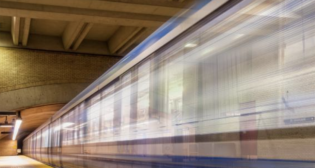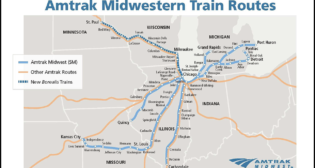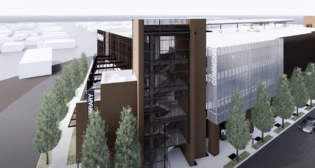
MBTA bets big on rail
Written by Douglas John BowenAn elder statesman among the growing crowd of U.S. transit properties, Massachusetts Bay Transportation Authority—the "T"—holds to its vision: expand its service area and service options. Watch Boston TV, listen to a radio station, and/or read a Boston-area newspaper (or news/opinion website) even casually and you'll find feedback on Massachusetts Bay Transportation Authority.
The “news” is often subjective, vehement, and per New England tradition fiercely critical. But it also highlights a singular reality: MBTA matters.
In fact, MBTA has mattered since 1964, when it was established as one of the earliest regional transportation authorities in the U.S., overseeing service to 78 Massachusetts municipalities holding most of the state’s population. MBTA itself arose from predecessor Metropolitan Transit Authority, created in 1947 to operate the Boston Elevated Railway Co. (BERY) serving just 15 cities and towns. Today, MBTA serves 175 municipalities as the fifth largest U.S. public transporation agency—and has plans to serve more communities, and more riders, in locations old and new.
MBTA officials know both their history and their mission, as the authority leverages $2.7 billion to bring its existing subway, light rail, regional rail, and bus operations to a state of good repair, and expand system reach west (to Worcester) and southeast (toward, but not quite reaching, Cape Cod communities).
MBTA ridership rose in March, April, and May, shaking off system declines evident throughout late 2008 and in 2009. Subway and bus (urban) systems generated the largest ridership increases; average weekday ridership on the Red, Blue, and Orange (subway/heavy rail) lines rose from 475,600 in May of 2009 to 490,000 a year later.
MassDOT, CSX reach consensus
MBTA regional (or “commuter”) operations are operated by Massachusetts Bay Commuter Railroad Co. (MBCR), a joint venture including Veolia Transportation, Bombardier Transportation, and Alternate Concepts, Inc., under contract until 2013. MBCR, or any successor, can count on operating over more mileage in the years ahead.
Skeptical observers questioned the ability of MBTA, or any Northeast regional rail agency, to find common ground with regional “newcomers” Norfolk Southern and/or CSX when the latter two divided Conrail’s property in 1999. Massachusetts, in at least two instances, successfully has surmounted such skepticism.
In June, Massachusetts Department of Transportation (MassDOT) and CSX Transportation reached a legal agreement for the Bay State to acquire 30 miles of right-of-way from Cotley Junction in Taunton, Mass., to Fall River and New Bedford, the first step in restoring passenger rail service from Boston’s South Station to the South Coast region (southeast of Boston). MassDOT and MBTA will control dispatching passenger trains once the South Coast Rail line begins operation. Said Lieutenant Gov. Timothy Murray, “By partnering with CSXT, we have reached a major milestone in this process, and it will be critical to use this investment to leverage future job growth, transportation services, and economic development in communities like Taunton, Fall River, and New Bedford.” About $30 million in federal funding will be available for upgrading rights-of-way, while another $20 million in TIGER stimulus funding will be used to replace three deteriorated bridges in New Bedford, beginning this fall.
MassDOT and CSX also reached accord on MBTA’s Framingham/Worcester Line, with MBTA purchasing rights-of-way and acquiring dispatch control and maintenance responsibilities. CSX retains user rights, and will assist Massachusetts in raising bridge clearances (and lowering track) to accommodate double-stack freight trains. A loose form of temporal separation will minimize potential freight and passenger conflicts.
Most important to CSX, the Class I railroad and MBTA reached an accord addressing CSX’s main concern, liability for accidents on the line. CSX will contribute $500,000 to help defray the cost of the liability insurance policy the MBTA carries for its rail operations; more important to CSX, it is responsible to pay a deductable on the policy, to a maximum of $7.5 million per accident, only if CSX is found responsible of willful misconduct in any accident. With other states, including Maryland, New Jersey, and New York, facing similar potential issues involving CSX (and/or Norfolk Southern), the accord was notable.
Rehabilitation and frustration
MBTA also is looking 50 miles northwest, to Fitchburg, Mass. The Fitchburg/South Acton Line, one of MBTA’s oldest in terms of infrastructure and notching the worst on-time performance on the system, is slated for much-needed attention through the Fitchburg Commuter Rail Line Improvement Project, which seeks to enhance service and reliability to about 10,000 existing daily riders traveling between its namesake cities and Boston’s North Station. The project is targeted for completion in 2012.
As well, MBTA has received $17.4 million from the American Reinvestment and Recovery Act (ARRA) for its Haverhill Commuter Rail Project, to improve reliability and service on its Haverhill Line running north of Boston. The Haverhill Line Project will add more double-track and address signaling problems that have hobbled ontime performance.
Boston never gave up on its four-branch light rail Green Line, one of the “seven surviving sisters” of light rail/streetcar operations soldiering on before the U.S. LRT comeback began in 1981. Today the Green Line B, C, D, and E routes notch 235,000 boardings per day. But MBTA’s harshest critics cite the authority’s seeming inability to execute improvements to its light rail system and—worse, to many—commit to expansion plans despite clear public consensus for such growth.
In July, the planned extension of the “T” Green line to Boston suburbs Somerville and Medford, a decades-long effort, was again delayed, with the newest completion date now pegged at October 2015. The current cost estimate, $954 million, is 50% higher than anticipated a few years ago.
Massachusetts is legally bound to complete the project, supposedly by 2014, because it is part of an agreed-to offset to the environmental impacts of Boston’s “Big Dig” highway construction (the 3.5-mile Central Artery/Tunnel Project which repositioned Interstate 93 through Boston), agreed to in order to comply with the federal Clean Air Act. State Transportaton Secretary Jeffrey B. Mullan, hoping to quell fears of the project’s supporters, has asserted, “This is, if not our top priority, one of our top priorities in the transportation world. It is a good project, it is a worthy project, and it’s one that we’re committed to.”
As for the existing Green Line, MBTA planned a summit early this month to ponder a $2.2 million study to install some form of a collision avoidance system, possibly ATP (automatic train protection), following a rash of accidents and incidents, often involving pedestrians. Subway portions of the Green Line are covered by automatic vehicle identification, but AVI reportedly does not work when vehicles run at street level.
MBTA’s focus on state-of-good-repair includes the need to upgrade its locomotive fleet of 80, 18 of which were originally manufactured between 1978 and 1980, and the youngest in the fleet at 17 years of age. Last June, MassDOT’s Board of Directors approved the purchase and/or lease of up to nine new locomotives from the Utah Transit Authority (UTA).
Following that move, last month the authority ordered 20 new diesel-electric locomotives from Wabtec subsidiary Motive Power, Inc. at a cost not to exceed $114.6 million. MBTA General Manager Richard Davey said the acquisition would immediately improve operations, allowing MBTA to retire its 20 oldest locomotives and reduce “associated mechanical failures.” The new locomotives also will meet Tier 3 emission standards as required by the Environmental Protection Agency.
But MBTA’s work here isn’t done; it estimates that by fiscal year 2013, 68% of its locomotive fleet will be scheduled for retirement. More equipment orders are likely.
Also arriving: 75 new bilevel cars from Rotem USA Corp., part of Hyundai Motors Group, expected to bolster MBTA’s bilevel fleet to 215 cars and replace older single-level cars. Delivery of the new cars, worth $190.2 million, began this year and will continue through 2012.
Gaps endure in the Hub
MBTA regional trains terminate either at South Station or North Station, and here MBTA may face its largest obstacle in integrating its services fully. Provisions were made for linking both stations during the “Big Dig,” but no serious effort is yet under way to provide such an option. For now, MBTA/MBCR customers can use the Orange Line between North Station and Back Bay Station, a major stop, to bridge the regional rail gap. Alternately, two subway transfer options (Red/Orange, Red/Green) are available. (Amtrak customers face a similar obstacle, as the Downeaster utilizes North Station, while its Northeast Corridor operations originate or terminate at South Station.)
As for providing better connectivity within Boston itself, MassDOT is proceeding with its Red Line/Blue Line Connector, to “link the only two lines that do not currently intersect within the MBTA’s rapid transit system.” The project would extend the Blue Line 1,500 feet underneath Cambridge Street to connect with Charles/MGH Station on the Red Line. In May the state certified its Draft Environmental Impact Report, and final design is expected by the end of 2011.



